There is a growing amount of useful data related to movement and maneuvering, including information related to walking or moving with an assistive device (see Figures 4.7 to 4.1 0). Although this data seems less plentiful, Panero and Zelnik do offer minimal parameters. Access guidelines such as those from the American National Standards Institute (ANSI), the International Codes Council (ICC), or Uniform Federal Accessibility Standard (UFAS) can be helpful. One critical rule is to consider the person and the aid as one. Also, just as for a person who does not use a mobility aid, these figures increase when the person using an aid goes from a static position to motion.
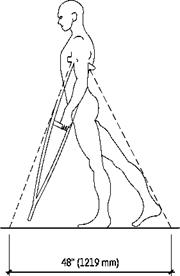
|
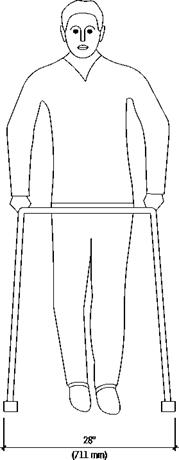
FIGURE 4.8 The width of a walker will determine the minimum clearance needed. (Based on Human Dimension & Interior Space by Julius Panero and Martin Zelnik, 1979, Watson-Gup – till Publications, p. 54.)
|
|
|
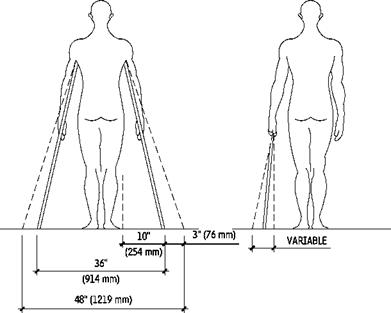
FIGURE 4.7 These minimum allowances will help In planning spatial clearance. Note that In this case, using the larger dimensions of percentile of adult males provides clearances for any human of smaller dimensions as well. (Based on Human Dimension & Interior Space by Julius Panero and Martin Zelnik, 1979, Watson-Guptill Publications, p. 54.)
|
|
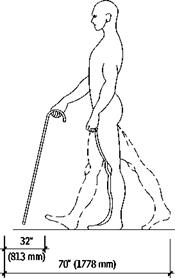
|
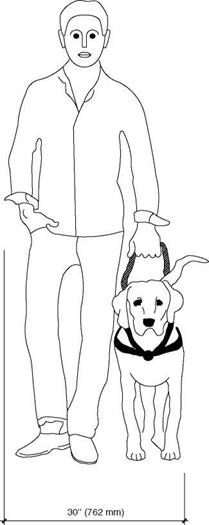
FIGURE 4.9 in this case, the clearance dimensions must be based on the actual user and dog, but the given dimension of 30 inches (762 mm) could be used as an absolute minimum. (Based on Human Dimension & interior Space by Julius Panero and Martin Zelnik, 1979, Watson-Guptill Publications, p. 54.)
|
|
|
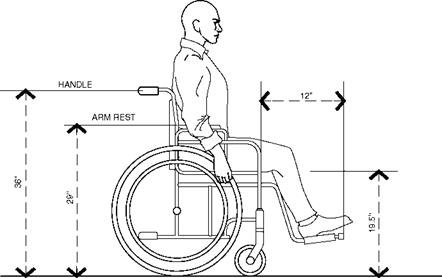
FIGURE 4.10 Although these standards for a person using a chair are useful in general, it is much better to measure the person in his or her chair. The variables are impacted by the person’s size and ability as well as the design and fit of the chair.
|
|
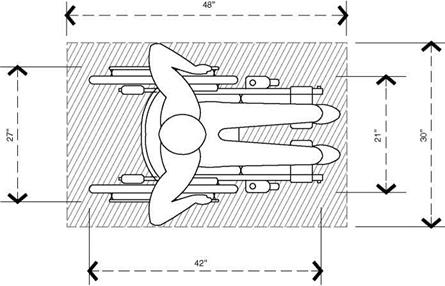
Comfort Zone
Based on psychological factors, we can also identify a body buffer zone or comfort zone. We maintain this personal space between ourselves and others who are walking, talking, or just standing with us (see Figure Figure 4.11) While we maintain a greater distance with strangers, the personal or close zone will be most applicable to bathroom design.
Anthropometry of Children
Historically there has been very little anthropometric data available regarding children. However, given the growing national focus on childhood health and safety, we can expect this to change. Although functional data would be most applicable, body dimensions of children are available and can be a starting point for the design of child-oriented spaces (see Table 4.2)

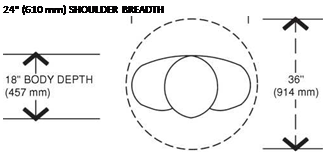 FiGURE 4.11 Based on a shoulder breadth of 24 inches (610 mm) and a body depth of 18 inches (457 mm), a minimum area of approximately 3 square feet (914 mm) per person is a guide in planning a space to be shared. (Based on Human Dimension & Interior Space by Julius Panero and Martin Zelnik,
FiGURE 4.11 Based on a shoulder breadth of 24 inches (610 mm) and a body depth of 18 inches (457 mm), a minimum area of approximately 3 square feet (914 mm) per person is a guide in planning a space to be shared. (Based on Human Dimension & Interior Space by Julius Panero and Martin Zelnik,
1979, Watson-Guptill Publications, p. 41.)
|
TABLE 4.2 the Height and Breadth of Children, Both Standing and Seated, Can Be Useful Dimensions When Planning a Bathroom That Must Accommodate Them as They Grow
|
Stature (Height)
|
6 years
|
11 years
|
|
95th Percentile
|
Boys
|
50.4" (1280 mm)
|
61.8" (1570 mm)
|
|
Girls
|
49.9" (1267 mm)
|
62.9" (1598 mm)
|
|
5th Percentile
|
Boys
|
43.6" (1107 mm)
|
53" (1346 mm)
|
|
Girls
|
42.6" (1083 mm)
|
53.3" (1354 mm)
|
|
Sitting Height
|
6 years
|
11 years
|
|
95th Percentile
|
Boys
|
27.4" (695 mm)
|
31.7" (805 mm)
|
|
Girls
|
27.1" (688 mm)
|
32.8" (833 mm)
|
|
5th Percentile
|
Boys
|
23.7" (602 mm)
|
27.6" (701 mm)
|
|
Girls
|
23.1" (588 mm)
|
27.4" (697 mm)
|
|
Elbow-to-Elbow Breadth
|
6 years
|
11 years
|
|
95th Percentile
|
Boys
|
11.3" (288 mm)
|
14.7" (373 mm)
|
|
Girls
|
11.1" (281 mm)
|
14.7" (373 mm)
|
|
5th Percentile
|
Boys
|
8.5" (217 mm)
|
10.1" (257 mm)
|
|
Girls
|
8.3" (211 mm)
|
9.6" (244 mm)
|
|
Hip Breadth
|
6 years
|
11 years
|
|
95th Percentile
|
Boys
|
9.3" (236 mm)
|
12" (305 mm)
|
|
Girls
|
9.3" (236 mm)
|
13.3" (338 mm)
|
|
5th Percentile
|
Boys
|
7.1" (181mm)
|
8.7" (221 mm)
|
|
Girls
|
7.1" (181 mm)
|
8.8" (223 mm)
|
|
Popliteal Height (to knee from floor when sitting)
|
6 years
|
11 years
|
|
95th Percentile
|
Boys
|
12.8" (325 mm)
|
16.3" (414 mm)
|
|
Girls
|
12.6" (320 mm)
|
16.4" (417 mm)
|
|
5th Percentile
|
Boys
|
10.4" (264 mm)
|
13.3" (338 mm)
|
|
Girls
|
10.2" (259 mm)
|
13.1" (333 mm)
|
|
Buttock- Popliteal Length (wall to back of knee when sitting)
|
6 years
|
11 years
|
|
95th Percentile
|
Boys
|
14.7" (374 mm)
|
19" (483 mm)
|
|
Girls
|
15.2" (386 mm)
|
19.9" (505 mm)
|
|
5th Percentile
|
Boys
|
11.3" (287 mm)
|
14.5" (368 mm)
|
|
Girls
|
11.3" (287 mm)
|
15" (381 mm)
|
|



![]()
 FiGURE 4.11 Based on a shoulder breadth of 24 inches (610 mm) and a body depth of 18 inches (457 mm), a minimum area of approximately 3 square feet (914 mm) per person is a guide in planning a space to be shared. (Based on Human Dimension & Interior Space by Julius Panero and Martin Zelnik,
FiGURE 4.11 Based on a shoulder breadth of 24 inches (610 mm) and a body depth of 18 inches (457 mm), a minimum area of approximately 3 square feet (914 mm) per person is a guide in planning a space to be shared. (Based on Human Dimension & Interior Space by Julius Panero and Martin Zelnik,






